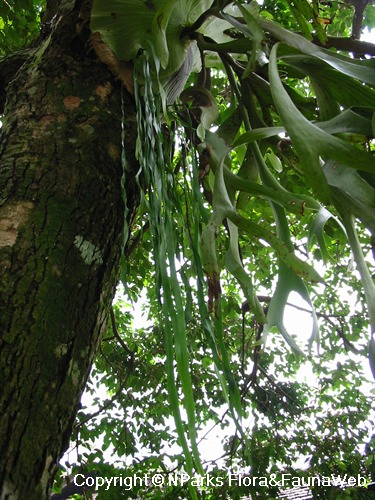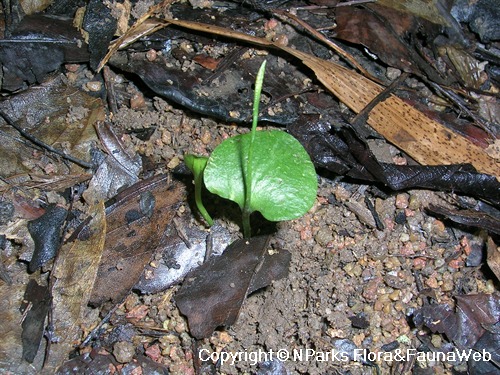
Back
Ophioglossum pendulum L.
| Family Name: | Ophioglossaceae |
| Common Name: | Ribbon Fern, Adder's Tongue Fern |
Name
Classifications and Characteristics
| Plant Division | Ferns & Lycophytes (Non-Seed Vascular Plants) (Fern) |
|---|---|
| Plant Growth Form | Epiphyte |
| Lifespan (in Singapore) | Perennial |
| Mode of Nutrition | Autotrophic |
| Plant Shape | Weeping / Pendulous |
| Maximum Height | 0.4 m to 1.2 m |
Biogeography
| Native Distribution | Madagascar, Tropical Asia to Polynesia, Indochina and South China (Hainan) |
|---|---|
| Native Habitat | Terrestrial (Primary Rainforest, Secondary Rainforest) |
| Preferred Climate Zone | Tropical, Sub-Tropical / Monsoonal |
| Local Conservation Status | Native to Singapore (Critically Endangered (CR)) |
Description and Ethnobotany
| Growth Form | It is an epiphytic fern with pendulous fronds, growing on palms, tree-ferns, trees, sometimes on rocks; in the lowlands and hills. |
|---|---|
| Foliage | Fronds light to mid green, pendent, tape or ribbon-like, 0.4m to 1.2m in length and 1cm to 4cm wide, often to 1.5m or more in cultivation. Fronds simple, or branching dichotomously. |
| Reproductive Parts - non-flowering plant | The spike produces numerous creamy white spores that are dispersed by wind. |
| Habitat | Grows in association with Platycerium species (Staghorn ferns) and Asplenium nidus (Bird's nest ferns); spores of the Adder's tongue fern rely on a fungus (mycorrhiza) to germinate that is found in the 'nest' of these ferns. In cultivation, the fern can be detached and grown separately from the Staghorn/ birdnest fern, |
| Cultivation | It can be propagated by spores. |
| Etymology | Greek Ophis, a snake; Greek glossa, tongue, referring to the slender fertile spike bearing the sporangia in this genus; Latin pendulum, hanging, pendulous, referring to the pendulous fronds. |
| Ethnobotanical Uses | Others: Its long, narrow leaves are shredded into coconut oil by the Moluccas, to be applied to the head for the improvement of the hair. |
Landscaping Features
| Desirable Plant Features | Ornamental Foliage, Ornamental Form |
|---|---|
| Landscape Uses | Parks & Gardens, Small Gardens, Interiorscape/ Indoor Plant, Container Planting, Suitable for Hanging Baskets |
Fauna, Pollination and Dispersal
| Seed or Spore Dispersal | Abiotic |
|---|
Plant Care and Propagation
| Light Preference | Semi-Shade |
|---|---|
| Water Preference | Moderate Water, Lots of Water, Occasional Misting |
| Plant Growth Rate | Fast to Moderate |
| Rootzone Tolerance | Shallow Media |
| Propagation Method | Spore |
Foliar
| Foliage Retention | Evergreen |
|---|---|
| Mature Foliage Colour(s) | Green |
Image Repository
Others
| Master ID | 263 |
|---|---|
| Species ID | 1559 |
| Flora Disclaimer | The information in this website has been compiled from reliable sources, such as reference works on medicinal plants. It is not a substitute for medical advice or treatment and NParks does not purport to provide any medical advice. Readers should always consult his/her physician before using or consuming a plant for medicinal purposes. |



